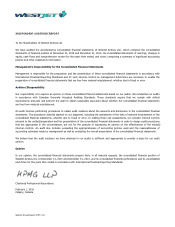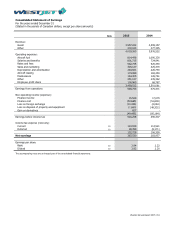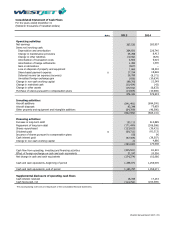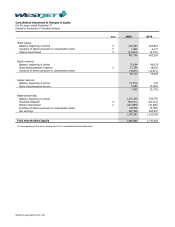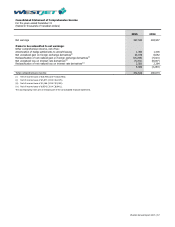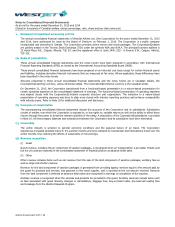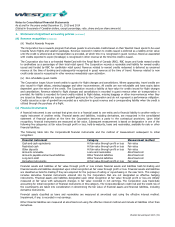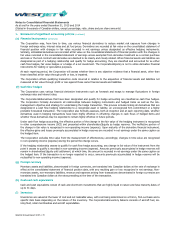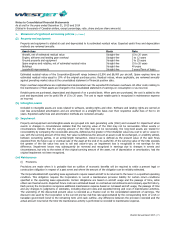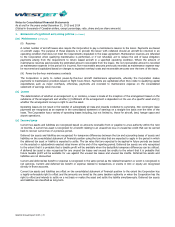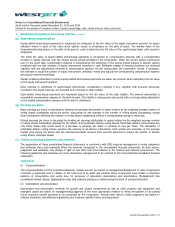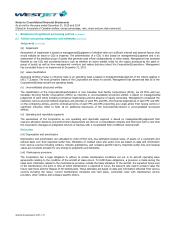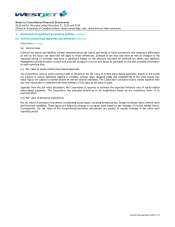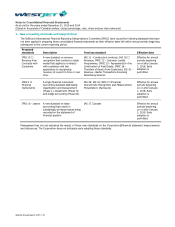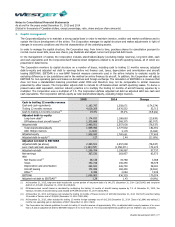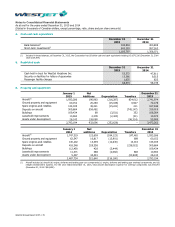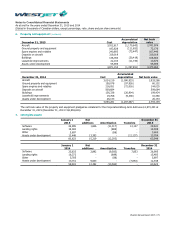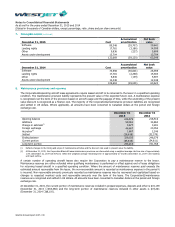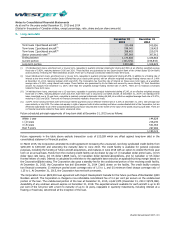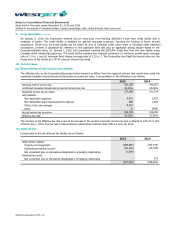Westjet 2015 Annual Report Download - page 74
Download and view the complete annual report
Please find page 74 of the 2015 Westjet annual report below. You can navigate through the pages in the report by either clicking on the pages listed below, or by using the keyword search tool below to find specific information within the annual report.
Notes to Consolidated Financial Statements
As at and for the years ended December 31, 2015 and 2014
(Stated in thousands of Canadian dollars, except percentage, ratio, share and per share amounts)
WestJet Annual Report 2015 | 72
1. Statement of significant accounting policies (continued)
(m) Maintenance (continued)
(ii) Reserves
A certain number of aircraft leases also require the Corporation to pay a maintenance reserve to the lessor. Payments are based
on aircraft usage. The purpose of these deposits is to provide the lessor with collateral should an aircraft be returned in an
operating condition that does not meet the requirements stipulated in the lease agreement. Maintenance reserves are refunded
to the Corporation when qualifying maintenance is performed, or if not refunded, act to reduce the end of lease obligation
payments arising from the requirement to return leased aircraft in a specified operating condition. Where the amount of
maintenance reserves paid exceeds the estimated amount recoverable from the lessor, the non-recoverable amount is recorded
as maintenance expense in the period it is incurred. Non-recoverable amounts previously recorded as maintenance expense may
be recovered and capitalized based on changes to expected overhaul costs and recoverable amounts over the term of the lease.
(iii) Power-by-the-hour maintenance contracts
The Corporation is party to certain power-by-the-hour aircraft maintenance agreements, whereby the Corporation makes
payments to maintenance providers based on flight hours flown. Payments are capitalized when they relate to qualifying capital
expenditures such as major overhauls, otherwise, payments are recorded to maintenance expense on the consolidated
statement of earnings when incurred.
(n) Leases
The determination of whether an arrangement is, or contains, a lease is made at the inception of the arrangement based on the
substance of the arrangement and whether (i) fulfillment of the arrangement is dependent on the use of a specific asset and (ii)
whether the arrangement conveys a right to use the asset.
Operating leases do not result in the transfer of substantially all risks and rewards incidental to ownership. Non-contingent lease
payments are recognized as an expense in the consolidated statement of earnings on a straight-line basis over the term of the
lease. The Corporation has a variety of operating leases including, but not limited to, those for aircraft, land, hangar space and
airport operations.
(o) Income taxes
Current tax assets and liabilities are recognized based on amounts receivable from or payable to a tax authority within the next
12 months. A current tax asset is recognized for a benefit relating to an unused tax loss or unused tax credit that can be carried
back to recover current tax of a previous period.
Deferred tax assets and liabilities are recognized for temporary differences between the tax and accounting bases of assets and
liabilities on the consolidated statement of financial position using the tax rates that are expected to apply in the period in which
the deferred tax asset or liability is expected to settle. The tax rates that are expected to be applied in future periods are based
on the enacted or substantively enacted rates known at the end of the reporting period. Deferred tax assets are only recognized
to the extent that it is probable that a taxable profit will be available when the deductible temporary differences can be utilized.
A deferred tax asset is also recognized for any unused tax losses and unused tax credits to the extent that it is probable that
future taxable profit will be available for use against the unused tax losses and unused tax credits. Deferred tax assets and
liabilities are not discounted.
Current and deferred tax benefit or expense is recognized in the same period as the related transaction or event is recognized in
net earnings. Current and deferred tax benefit or expense related to transactions or events in OCI or equity are recognized
directly in those accounts.
Current tax assets and liabilities are offset on the consolidated statement of financial position to the extent the Corporation has
a legally enforceable right to offset and the amounts are levied by the same taxation authority or when the Corporation has the
right to offset and intends to settle on a net basis or realize the asset and settle the liability simultaneously. Deferred tax assets
and liabilities are classified as long-term.


